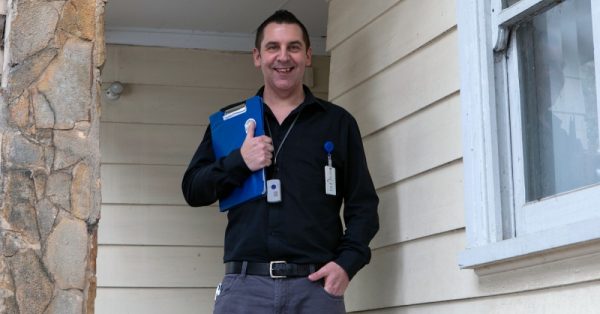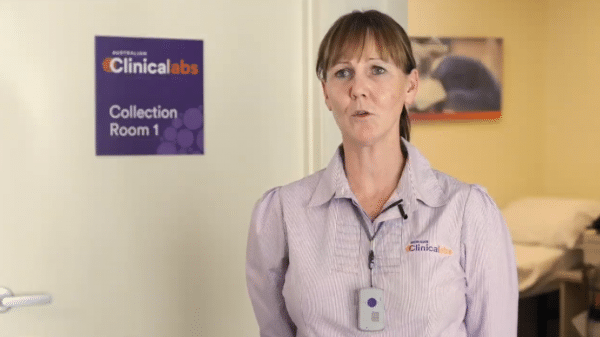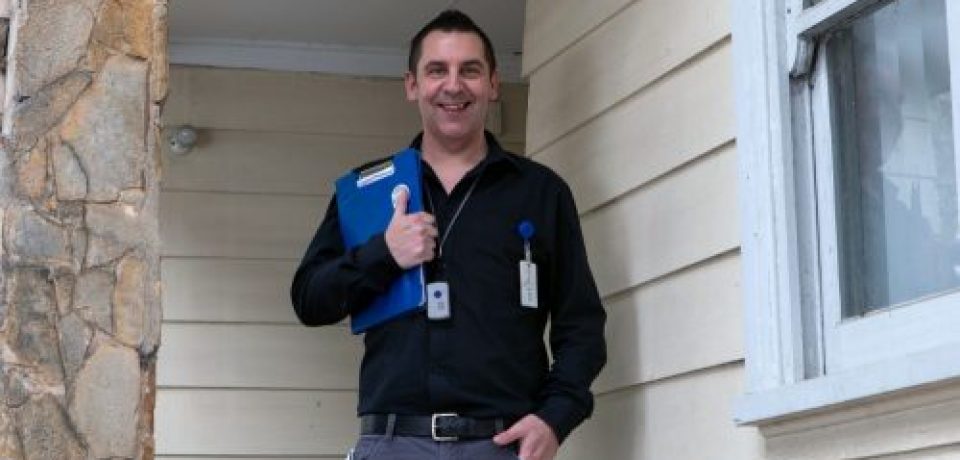According to the latest data released from WorkSafe, up to 95% of our healthcare workers have experienced verbal or physical assault at work. This is a serious issue in the healthcare industry and needs to be addressed. Workers are regularly confronted with violence and aggression – from patients, residents, visiting friends and family or even bystanders.
Work related violence can happen in any industry but occurs significantly in healthcare, aged care, social, disability and youth services; with those who are working alone and/or out in the community more vulnerable.
Lone worker safety is the employers’ responsibility, and they must ensure that their staff feel safe and supported when doing their job. A duress alarm device is a great tool to provide safety and reassurance to lone workers, so they can call for help if they find themselves in an unsafe situation or have concern for their safety.
Download MePACS’ Duress Alarm brochure
Who should use a duress alarm?
Workers with the highest risk are people who work alone out in the community, work at night or outside business hours, people that handle drugs or provide care to patients who are distressed, ill or incarcerated.
How does it work?
Staff can check in before they enter a property to confirm their exact whereabouts or let us know if they have concerns. If help is required, a simple button press will activate the alarm and a member of our emergency response team will speak through the alarm within two minutes. The duress alarm can also be used during a medical emergency and can be used hands free whilst conducting CPR or providing care.

The details
A duress alarm allows a lone worker to raise an alarm when there is no one else around to offer support. The alarm works by pressing one single button which goes through to a response centre to be answered by trained professionals. The operator can identify what help is required through speaking with the user or listening into the situation and then calling the appropriate help and back up. The personal alarm device has a GPS locator in so the user’s location can be identified and help sent quickly.
Many healthcare workers in particular visit clients at their home, therefore the environment they are entering is an unknown. Matt, a Senion Clinician from Peninsula Health, says “lone workers like myself are vulnerable going into patients home alone. Thanks to the MePACS Duress alarm, I now have greater peace of mind that if something happens, I’m not alone”.
The Lone Worker Duress safety alarm works on the 4G mobile phone network anywhere in Australia. It is important to note that if the alarm is in an underground car park, in rural or mountainous areas then it may not have coverage. It has an indicator light to show you when you have coverage or not.
What risks does a lone worker face?
Many social workers and medical professionals conduct home visits, if an emergency situation where a threat of violence occurs many of these lone workers may not have immediate access on their person to their mobile phone, have time to unlock it and then call for help. The benefit of a lone worker alarm is the ease and speed of calling for help in a distressed situation.
Physical risk isn’t the only issue for lone workers. Mental health risks can be a problem too. The lack of contact and social support from co-workers and employees can lead to frustration as well as a feeling of isolation and stress. Stress affects the wellbeing of employees and can also have a direct impact on the company itself. While introducing a duress alarm into your workplace may lead to an increase in staff retention through better morale it can also reduce employee stress and sick leave.
72% of users with the MePACS Duress Alarm say they feel less stressed or significantly less stressed at work having the MePACS Duress Alarm than they did before, with no alarm.
What is a Duress Alarm system?
A duress alarm is a small personal alarm, often the size of a pendant, which should be carried on your person at all times. In the event of an incident the user can press the help button and the signal will go through to a response centre and answered by trained professionals. The operators will talk to the user via the alarm or listen to the situation and then call for the most appropriate help, which could be, ambulance, police or a manager/security. All calls are recorded and can be used later as evidence, if required.
What does a Duress Alarm do?
A duress alarm allows a worker to feel confident to get on with their job. Knowing that if they need emergency assistance they just need to press the help button on their alarm. Some duress safety alarms are connected internal escalation systems where others are connected to a monitored response service like MePACS. In the event of an accident, violence, assault, fire or medical emergency once the alarm is pressed MePACS will contact you within 2 minutes to find out what help you need and call either a manager, security team or emergency service.
81% of users with a MePACS Duress Alarm feel safer when out and about.
Download MePACS duress alarm Brochure
What areas do Duress Alarms work in?
The MePACS Duress Alarm works anywhere in Australia that has mobile phone coverage. If the alarm is in an underground car park, in rural or mountainous areas then it may not work.
The MePACS Lone Worker alarms are available in Victoria, New South Wales, Tasmania, Queensland, North Territories, ACT, South Australia and Western Australia.
What is the difference between a Personal Alarm system & a Duress Alarm?
Some people may refer to these alarms by different names. At MePACS, there is no difference between the two names – they are the same personal alarm device.
What types of Duress Alarms are there?
The most basic duress alarm systems will feature an emergency call feature, that send a text based message to a contact or a manager to check in on the lone workers. In a true emergency the response for help could be delayed and puts the responsibility of monitoring their staff on the managers. A fully monitored service have trained professionals ready to answer a call for help fast, 24/7 and then send the appropriate help, guaranteeing the lone workers is fully supported all the time.
When should I activate a Duress Alarm?
Whenever a worker feels that their safety or health is under threat they should press their duress alarm button. Situations could be, the patient, a family member or even a dog becomes aggressive, yours or your client’s health needs urgent medical treatment and you need to call for help, if there’s a fire, theft or accident. A duress device should always be used in conjunction with company protocols, procedures and de-escalating techniques. By pressing their duress alarm it can reduce the user’s stress and give them reassurance that they know immediate assistance is on the way.
Who needs a Duress Alarm?

Anyone who is a lone worker, a high risk worker, or anyone that works remotely out in the community or in dangerous circumstances should look into obtaining a personal duress alarm. This could be medical professionals like doctors, health care workers like nurses, social workers, psychologists, pathologists, and possibly aged care workers. Many of these professionals work alone in stand-alone buildings with little support from others.
Sarah from Clinical Labs needed to press her MePACS Duress Alarm one day when a regular patient of hers became agitated and the situation quickly escalated. She explains how pressing her MePACS Alarm deescalated the situation when the MePACS response monitor spoke through to her through her alarm the patient quickly fled the building, allowing Sarah to lock the doors and keep herself and fellow patients safe.
Download Our Ultimate Guide To Duress Alarms
Consequences of not having a Duress Alarm system?
The personal safety of staff, especially lone workers ff members should be a high priority for employers. Employees need to feel valued, supported and safe when at work. By companies failing to provide adequate safety measures for their teams, can have dramatic consequences. This can range from low staff morale, increased sick leave, increase mental health leave and high staff turnover. If staff don’t feel supported they may not be able to do their job to the best of their ability, which in-turn has a great effect of worker productivity.
95% of staff with a MePACS Duress Lone Worker Alarm feel more positive towards their employer by offering this alarm to them.
With the MePACS Duress Alarm, once a user has pressed the button, help is only 2 minutes away. Our trained operators are always ready to get you the appropriate help, any time of the day or night. We know that family may not always be available to help 24/7 so you can rely on us to give you and your employee’s true peace of mind.
Where can I buy a Duress Alarm?
You can purchase a Duress Alarm system from MePACS Personal Alarms or call 1800 685 329.
MePACS is a 24/7 fast response personal alarm service responded to by trained professionals, based in Australia. We have been keeping communities safe for over 30 years. MePACS is one of the largest and well respected personal alarm services in Australia, backed by an Australian Public Health provider.
We have over 43,000 clients in Australia who trust us to keep them safe.
MePACS provides the highest level of professional customer service, providing peace of mind for both our clients and their family.
With the MePACS personal alarm, once you have pressed your button we respond within 2 minutes, 24 hours a day.
What Duress Training do you offer?
Depending on the number of unit that are purchased MePACS offer online and face to face training for their Duress Alarm, free of charge. Plus we supply a range of training videos for staff who cannot attend training session as well and the traditional training booklet to get you started.
How do you reset a Duress Alarm?
With the MePACS Duress Safety Alarm if the alarm has been switched off or gone into standby mode you can turn it back on by placing the device into the charging cradle. Once the alarm turns back on the light will flash orange then green once re-established mobile phone coverage.
MePACS an alternative to SafeTCard
MePACS is an alternative to SafeTCard – both companies are well known industry leaders in the duress alarm space.
Over 50% of the healthcare organisations in Victoria are using the MePACS Duress Alarm. Including: Monash, Eastern Health, Bass Coast, Northern Health, Mercy Health, Clinical Labs, Dorevitch and Peninsula Health. And MePACS is rated 5/5 stars for their service, by their clients.
The below table highlights some key differences between MePACS & SafeTCard.
Product |
MePACS |
SafeTCard |
Size of Alarm |
65 x 40x x 20 mm | 102 x 72 x 12 mm |
Weight |
58 grams | 78 grams |
Features |
GPS | GPS |
|
|
Two Way Voice | Two Way Voice |
|
|
Built in Mic | Build in Mic |
|
|
Calls are recorded | Calls are recorded |
|
|
Unique ID or can share devices by teams | Unique ID so device allocated to unique user |
Response time |
Within 2 minutes | No set time |
Monitoring Service |
Yes – 24/7 Monitoring in Australia | Yes – 24/7 Monitoring in Australia |
Years of Service |
30 years’ experience | 9 years’ experience |
Training |
Personalised onboarding face to face Training based on volume purchased | Online Training |
States available in |
All States in Australia | All States in Australia |
How much is a MePACS Duress Alarm?
The MePACS Duress Alarm starts at $350 per device and $35 a month ex GST for the 24/7 emergency response team. The response team will respond to your call within 2 minutes, so you’ll have the peace of mind to know help is always available at the touch of one button away.
join mePACS now Download Brochure
